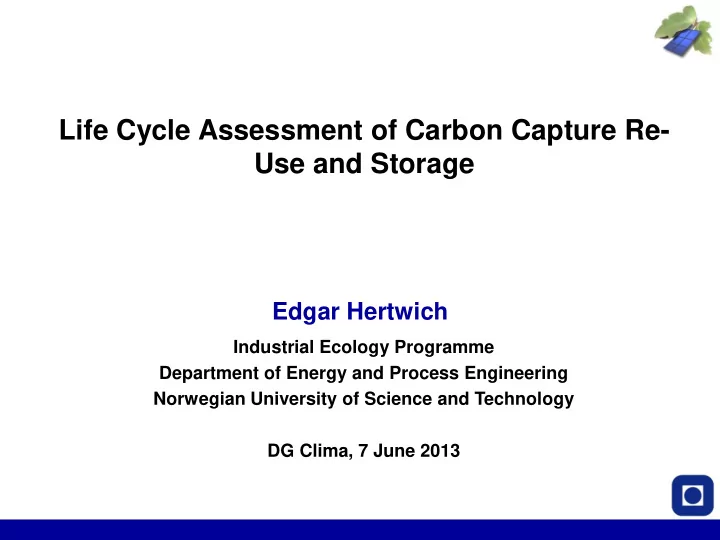

Life Cycle Assessment of Carbon Capture Re- Use and Storage Edgar Hertwich Industrial Ecology Programme Department of Energy and Process Engineering Norwegian University of Science and Technology DG Clima, 7 June 2013
CONTENTS • Life cycle assessment • CCS • Electrochemical Reduction to Formic Acid • Conclusions Industrial Ecology Programme – NTNU edgar.hertwich@ntnu.no CO2 reuse workshop, DG Clima
Why LCA? Product flows between processes Emissions What is the total amount of environmental stressors connected to a comparable service? Basis for comparison and Functional Unit for upscaling. 15000km transport Industrial Ecology Programme – NTNU edgar.hertwich@ntnu.no CO2 reuse workshop, DG Clima
LCA of CCR and CCS Does it make sense as a Resource and climate mitigation step? environmental trade-offs What are the energy, What are the resources chemical and required? infrastructure Does the process have requirements and the higher or lower emissions associated GHG of air/water/soil emissions? pollutants cp to How large is the emission conventional fossil or reduction that can be renewable alternatives? achieved? Industrial Ecology Programme – NTNU edgar.hertwich@ntnu.no CO2 reuse workshop, DG Clima
Power station with CCS Post-combustion capture, transport and storage system Industrial Ecology Programme – NTNU edgar.hertwich@ntnu.no CO2 reuse workshop, DG Clima
CCS: Trade-off between impact categories Absolute Recipe Impact Scores for NGCC w Postcombustion CCS • Increase in all environmental impacts except decrease in GHG. Singh, B., A. H. Strømman, and E. Hertwich. 2011. Life cycle assessment of natural gas combined cycle power plant with post-combustion carbon capture, transport and storage. International Journal of Greenhouse Gas Control 5(3): 457-466. Industrial Ecology Programme – NTNU edgar.hertwich@ntnu.no CO2 reuse workshop, DG Clima
NGCC POST-COMBUSTION CCS STRUCTURAL PATH ANALYSIS OF GWP - Contributions Industrial Ecology Programme – NTNU edgar.hertwich@ntnu.no CO2 reuse workshop, DG Clima
LCA of CCS – Adjusted fugitive emissions 1,2 Significant reduction 1,0 -20% -47% 0,8 kg CO 2 e/kWh of direct emissions -82% 0,6 with CO2 capture. Infrastructure + supplies 0,4 Emissions from fuel chain More attention 0,2 Direct emissions 0,0 required to fuel chain. Contribution of Error bars indicate current literature infrastructure small. range. LCA based on Singh et al. (2011) adjusted for fugitive emissions acc. to Burnham et al. (2012). Industrial Ecology Programme – NTNU edgar.hertwich@ntnu.no CO2 reuse workshop, DG Clima
Electrochemical Reduction Formic acid: Preservative, antibacterial agent, tanning. Demand: 1 Mt/y Commonly produced from methane - methanol Electrochemical reduction of CO 2 shown feasible in experiments; papers and patents published Industrial Ecology Programme – NTNU edgar.hertwich@ntnu.no CO2 reuse workshop, DG Clima
LCA results for EOR High requirements of Resource inputs to electrolysis electricity, chemicals Low concentration product Very high energy Emissions including distillation requirement for extractive distillation High emissions given the overall inefficiency of the process. A. Dominguez-Ramos, B. Singh, X. Zhang, E.G. Hertwich; , TCCS conference 2013 Industrial Ecology Programme – NTNU edgar.hertwich@ntnu.no CO2 reuse workshop, DG Clima
LCA of CO 2 Re-Use Life cycle assessment is Thermodynamics and critical for identifying systems analysis are key which options make sense for conducting LCAs of this from a climate mitigation type of processes. perspective. Industrial Ecology Programme – NTNU edgar.hertwich@ntnu.no CO2 reuse workshop, DG Clima
Recommend
More recommend